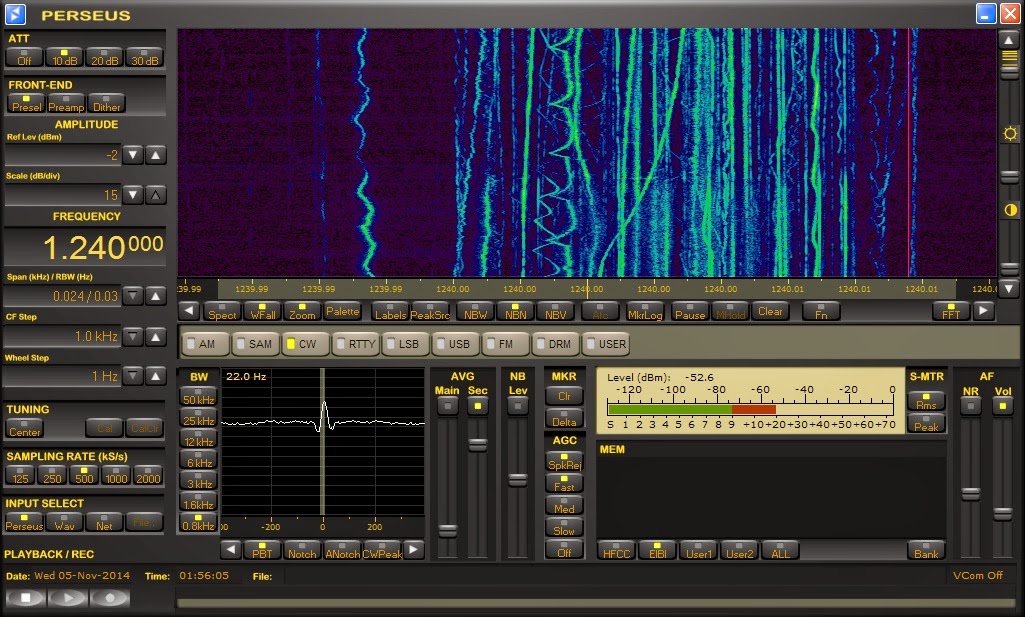 Perseus Deep Search
Perseus Deep Search
 It's always interesting to use one of the many 'audio viewing' software programs, such as 'Argo', 'Spectran' or Spectrum Lab, driven with receiver audio, to dig deep into a section of the spectrum using very narrow bandwidths. The narrower the bandwidth becomes, the greater the signal-to-noise ratio, increasing sensitivity in effect. The use of digital signal processing software can create the extremely narrow milliHertz filtering needed to view signals buried deep in the noise...the deeper the search (20db, 30db or more into the noise), the longer the time needed to build up the visual display of signals that would be far too weak to detect aurally.
It's always interesting to use one of the many 'audio viewing' software programs, such as 'Argo', 'Spectran' or Spectrum Lab, driven with receiver audio, to dig deep into a section of the spectrum using very narrow bandwidths. The narrower the bandwidth becomes, the greater the signal-to-noise ratio, increasing sensitivity in effect. The use of digital signal processing software can create the extremely narrow milliHertz filtering needed to view signals buried deep in the noise...the deeper the search (20db, 30db or more into the noise), the longer the time needed to build up the visual display of signals that would be far too weak to detect aurally.Recently, rather than using Argo to view a slice of spectrum I set up the Perseus waterfall display to have a deep-look at 1240kHz. This is one of the broadcast-band's 'local' channels and one that BCB DXers refer to as a 'graveyard channel'. Almost all stations on the various graveyard frequencies run a maximum of 1kW day and night. According to the Medium Wave List, there are presently 166 stations in North America operating on 1240kHz...one of the reasons that 'DXing the graveyards' is so interesting.
With this in mind, I recently took a mid-afternoon listen. Just one station was audible to my ear, likely one of the stations to my south in Washington state. Centering Perseus on 1240kHz, the waterfall was set to display a ~50Hz slice of the spectrum...1240kHz +/- 25Hz. The screen below shows the display, ranging from 1239.976kHz to 1240.024kHz. After letting the waterfall visual display slowly build up, it revealed 26 separate carriers. The remaining signals, although propagating to my location, were too weak to be detected aurally.
 | ||
| 26 midday carriers visible on 1240kHz |
Next I switched to an even narrower filter, at twice the previous resolution, visible on the top-half of the waterfall above. This displayed a ~25Hz spectrum slice, still centered on 1240kHz. Although finer resolution is evident, there appears to be no additional signals except for the three new arrivals slowly fading in at the right as sunset creeps closer.
The screen above was made approximately one hour after sunset (looping E-W) and shows the same 25Hz slice centered on 1240kHz. There are ~70 carriers visible by now, with most of them fading. Some transmitters appear to be rock-solid while most exhibit a cyclical drift, no doubt the result of some form of crystal temperature stability attempt. I'm guessing that the rock-solid ones are using more modern synthesizers for frequency generation.
Listening on 1240 during this period reveals a boiling cauldron of audio, mostly unreadable until one station fades-up and becomes intelligible for a short period before fading to be replaced by another. Sitting on this frequency at the top-of-hour identification time can often catch a few idents with careful listening.
Even comparatively empty 540kHz reveals 22 different carriers, the only audible one being CBK in Watrous, Saskatchewan, the brighter trace at 540.002kHz. The one at the right looks as if it may have just come on the air for the evening. It's possible that many of these are low powered traffic information stations (TIS) running at 10 watts.















